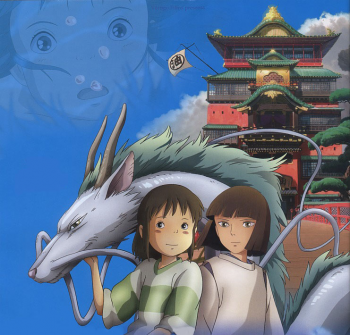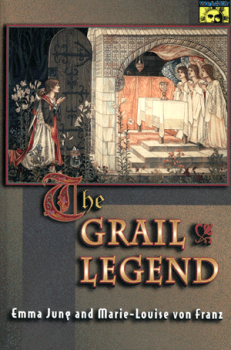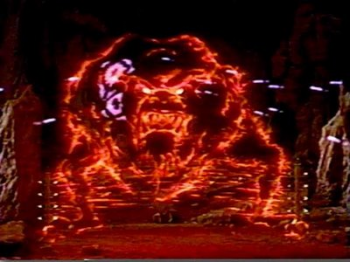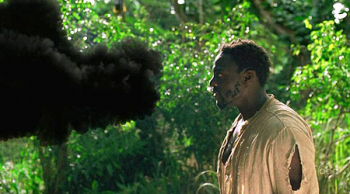Jung and Lost
Ted Friedman / Georgia State University – Atlanta

In my last column’s discussion of synchronicity in sports and games, I mentioned my interest in bringing the ideas of Carl Jung into dialogue with cultural studies. Jung’s psychology has a poor reputation in contemporary cultural theory. It’s widely thought to be essentialist, anti-materialist, and politically conservative. Theories of ideology searching for models of subjectivity have long bypassed Jung, turning instead to Freud via Althusser and Lacan. But the dismissive caricature of Jung distorts his ideas and rejects a model of the unconscious that could be of great use to understanding the psychodynamics of twenty-first century culture. In this essay, I’d like to begin demonstrating the value of Jung’s ideas for understanding one of the most resonant contemporary representations of the terrain of the unconscious: Lost.
Jung is perhaps best known, to non-Jungians, for his split with Freud in the early twentieth century over the nature of the unconscious. Freud conceived of the unconscious as the repository of the individual’s repressed fears and urges. Jung, while acknowledging this aspect, argued that the unconscious is also a source of wisdom and power. He postulated the existence of a second layer beneath the personal unconscious, a collective unconscious, which houses “archetypes” – primal structures of energy transcending social and cultural circumstances.
It is this emphasis on transhistorical archetypes which gets Jung labeled an essentialist, which is about the worst thing a theorist can be called these days. And indeed, over the years many Jungians have drawn on his theories to claim an archetypal basis for “traditional” relations of class, gender and sexuality.1 But as a newer generation of “post-Jungian” scholars has pointed out, Jung’s actual theory is much more fluid – and radical – than this rigid application presumes.2

Jung distinguishes between “archetypes” and “archetypal images.” Archetypes per se are inaccessible to consciousness and unrepresentable. They can only be glimpsed through specific archetypal images. These images are always culturally contingent, inflected differently in each different historical and cultural context. Archetypal images, then, are where archetype meets ideology.
In addition, in Jung’s model of the psyche, archetypes function not to stabilize identity, but to disrupt it in order to bring about change, healing, and ultimately transformation through the process Jung called “individuation.” For example, Jung’s archetype of the anima/animus, the contrasexual “soul-image” within the psyche, prods and challenges fixed gender identity, introducing the feminine within masculine men, and the masculine within feminine women. While Jung himself was not above recourse to the gender stereotyping of his era, in this model of a fragmented, androgynous psyche, he was well ahead of his time.3
One reason to turn to Jung’s ideas today is because popular culture seems to be growing more and more Jungian. Film studies emerged in the 1950s and 1960s, when the ideas of Sigmund Freud caught hold of the imaginations of scholars of film and literature, as well as artists such as Alfred Hitchcock. The Freudian emphasis on Oedipal dynamics, and the Freudian model of the ego keeping a tight lid on the seething id, seemed a clear fit with influential Hollywood genres such as melodrama, horror, the thriller, and film noir. Lacanian Screen theory updated Freud with a poststructuralist twist, and cultural studies has largely followed suit.

But today it is Jung’s shadow which looms over much of American culture. The most commercially successful Hollywood genres of this decade are fantasy and superhero movies, subjects which in previous generations were viewed as kids’ stuff, but today claim a larger portion of culture than ever before. These genres reject conventional models of realism and psychological depth. Instead, they embrace magical storytelling and characters of outsized dimensions and godlike powers. These qualities have led them to be largely dismissed by conventional cultural critics (beyond fan studies scholars who have tended to emphasize audience reception over the textual properties of the stories themselves). But these same qualities are well described by the Jungian language of archetypes and the collective unconscious. Their roots are in the storytelling traditions of myth and fairy tale – exactly the genres Jungian analysts have always most valued.4

The gap between Jungian and Freudian models of the unconscious can be seen in the difference between Lost and its 1950s antecedent, the science fiction film Forbidden Planet. (Both stories, in turn, owe clear debts to Shakespeare’s The Tempest.) Each narrative follows heroes who explore a mysterious, isolated location – a lost space colony in the case of Forbidden Planet, a hidden island in the case of Lost. In both stories, the visitors are threatened by an amorphous monster, representing the depths of the unconscious (and reworking Shakespeare’s Caliban).
In Forbidden Planet, following the pop-Freudianism of the era, we are explicitly told that the villain is a “monster of the id,” produced by alien technology which channels the “subconscious hate and lust for destruction” of its users. The Id Monster is pure threat: the repressed, dangerous, irrational side of civilization, “the secret devil of every soul on the planet.” We learn that the monster destroyed the Krell, the planet’s original inhabitants. It is reawakened by scientist Morbius’s repressed sexual jealousy over the visitors’ interest in his daughter. The monster is only vanquished when the planet is blown up.

In Lost, the “smoke monster” is a powerful force which appears to be at the center of the island’s many mysteries (most of which have yet to be revealed at this writing). It destroys some people it encounters, such as Mr. Eko, a former drug lord who refuses to admit remorse. It spares others, most recently Benjamin Linus, a leader responsible for many deaths who promises to follow its instructions. It appears to even have the power to resurrect the dead, bringing John Locke back to life when his corpse is returned to the island.

The smoke monster, and the magic it represents, is not exactly Forbidden Planet‘s image of the indiscriminately vengeful Freudian unconscious. But neither is it the model of the unconscious idealized by some of the more starry-eyed New Age descendants of the Jungian tradition.5 It is dangerous, unpredictable, and unwilling to subordinate itself to conscious intention. But it is also a source of immense strength and transformation for those who engage it.
The smoke monster is clearly a source of archetypal energy, but it must express itself through specific archetypal images. It tends to instantiate itself in deceased figures from characters’ pasts – Mr. Eko’s brother Yumi, Ben’s daughter Alex, Jack Shepherd’s father Christian. In this interest in family history (and particularly Oedipal conflict), the monster might seem to reflect a Freudian sensibility. But as Robert Segal puts it, “for Freudians, gods symbolize parents. For Jungians, parents symbolize gods, who in turn symbolize father and mother archetypes, which are components of the hero’s unconscious.”6 We have recently learned that the smoke monster is housed in the ruins of an ancient temple amid hieroglyphics and drawings of Egyptian gods. The families of the host characters are clearly only the most recent of the many guises the “monster,” an ancient source of power, has taken.
Image Credits:
1. Carl Jung
2. Spirited Away
3. Psycho
4. The Grail Legend
5. Id Monster
6. Smoke Monster
Please feel free to comment.
- David Tacey levels this critique at Robert Bly and Joseph Campbell, among others, in Remaking Men (New York: Routledge, 1997) and Jung and the New Age (New York: Routledge, 2001). See Robert Bly, Iron John (Reading, MA: Addison-Wesley, 1990); Joseph Campbell and Bill Moyers, The Power of Myth (New York: Doubleday, 1988). [↩]
- See Andrew Samuels, Jung and the Post-Jungians (New York: Routledge, 1985) and The Political Psyche (New York: Routledge, 1993); Christine Gallant, Tabooed Jung (New York: New York University Press, 1996); Christopher Hauke, Jung and the Postmodern (New York: Routledge, 2000); Susan Rowland, Jung: A Feminist Revision (Cambridge: Polity, 2002); Polly Young-Eisendrath and Terence Dawson, eds., The Cambridge Companion to Jung (Cambridge: Cambridge University Press, 2008). For a rare, intriguing attempt to bring Jung and post-Marxist theory into dialogue, see Janice Hocker Rushing and Thomas S. Frentz, “Integrating Ideology and Archetype in Rhetorical Criticism,” The Quarterly Journal of Speech 77 (1991): 385-406. See also their Jungian study of American film, Rushing and Frenz, Projecting the Shadow (Chicago, IL: University of Chicago Press, 1995). [↩]
- For feminist perspectives on Jung, see Rowland, Jung: A Feminist Revision and Tacey, Remaking Men. [↩]
- See, for example, Emma Jung and Marie-Louise von Franz, The Grail Legend (Princeton, NJ: Princeton University Press, 1998); Marie-Louise von Franz, The Interpretation of Fairy Tales (Boston, MA: Shambhala Press, 1996). For contemporary Jungian perspectives on myth, see Lucy Huskinson, ed., Dreaming the Myth Onwards (New York: Routledge, 2008). [↩]
- See Tacey, Jung and the New Age. [↩]
- Robert Segal, “Introduction,” in Robert Segal, ed., Hero Myths: A Reader (Malden, MA: Wiley-Blackwell, 2000). [↩]
Another grand piece, this time teaching me to look out for Jung in all the wrong places. It is an important lesson to remember to keep our eyes out for hidden psychoanalytic framework-trends, and the fan of Lost should have a better understanding of the show after reading this column.
Great read — very thought provoking.
I see an interesting archetype in “Slumdog Millionaire” and the films of M. Night Shyamalan. These films all depict a world in which things always happen for a reason — as if directed by some divine force (or the energy of a “collective unconscious?”) What would Jung say about the popularity of these films?
Pingback: Sunday Links | MarkSimon.de
thank you for making this connection. i have been writing a paper over the past few weeks titled the peacemaker’s war in which i tell the story of my journey as a peacemaker to find my the shadow archetype in my brother and his experience in the military. this “othering” that i would do with jason and his ‘evil shadow military side” was abruptly erased when he was killed last year.
this process of losing my archetypal image (as well as brother) has allowed me to notice that my projections of my brother as the shadow warrior that i have rejected in myself and the actual life of my brother were two very different things.
i appreciate the connection you made between the lost monster and jung’s archetypal images. i am a big fan of lost and found the connections fascinating.
i would like to think (like john locke or benjamin lyon) that now that i am engaging with my shadow archetypal story and calling it for what it is, it will bring great strength and transformation.
my hope is that the peacemaking community that i live within will see my experience as a way to find their own shadow archetypal image and begin to speak openly about it.
i dont know that its fair to make massive generalizations about fields (as i’ve found thats what i have done with the military) but i also find myself wanting to claim that the peacemaking community on a massive scale uses the military as their shadow archetypal image.
not sure if that’s just me projecting but its somethign i’m exploring.
thanks!
Pingback: Syllabus « Pop Culture E2043
Joseph Campbell often referred to Jung in his study of mythology. And Campbell made note of the fact that Christian churches literally physically subsumed pagan temples. There is no doubt that Christian achetypes subsumed pagan archetypes, too.
Pingback: What I’ve Been Up to the Last Five Years | TedFriedman.com
Pingback: New Interview on the Diet Soap Philosophy Podcast | TedFriedman.com
Another grand piece, this time teaching me to look out for Jung in all the wrong places. It is an important lesson to remember to keep our eyes out for hidden psychoanalytic framework-trends, and the fan of Lost should have a better understanding of the show after reading this column.